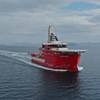Gladding-Hearn Shipbuilding, The Duclos Corporation, has begun construction of a new all-aluminum catamaran, which will join three other high-speed ferries built by the shipyard for Boston-based Boston Harbor Cruises. Measuing 142.6 ft. on the deck, 39 ft. abeam and carrying 500 passengers, the new vessel will be the largest Incat-designed fast ferry in the country, said shipyard officials. Delivery is scheduled for next June.
Designed for commuter service, whale watching and passenger coastal excursions by Australia-based Incat Designs, the ferry's stylish lines resemble a modern megayacht. The architectural style was deliberate, says Peter Duclos, who heads the shipyard's business development.
"The owner plans to charter the boat for coastal cruises, and therefore, wanted an especially distinctive design, which also optimizes the use of functional space" he says.
The vessel's forward windows, for example, are vertical to allow for more interior space than sloped forward windows generally found on most fast ferries today. The open stairway to the upper deck - the centerpiece of the main cabin - offers passengers a greater sense of openness. Each cabin also includes three heads, lounge area, a cocktail and food-service bar, and upholstered seating and tables, which can be rearranged for private parties.
Powered by four Caterpillar 3512B diesel engines, each delivering 1,950 hp and driven by KaMeWa A56 waterjets through ZF BW 465D gearboxes, the vessel is expected to reach a top speed of 37 knots when fully loaded. It is equipped with a Maritime Dynamics active motion-control system.
A motion sensor actuates a computer in the wheelhouse to adjust the large trim tabs, thus reducing the motion on the vessel as much as 60 percent, providing passenger comfort and minimal loss of speed in rough seas.
The company is building the vessel in modules, which Duclos says is the more modern way to construct a vessel. In addition to the obvious benefits - such as an approximate 25-30 percent reduction in delivery time, Duclos says the fact Gladding-Hearn can even build these vessels is benefit enough to build vessels in modules.
"Building the vessel in modules allows smaller yards to build bigger vessels," he says. "There's only one place big enough in our yard to build a vessel of this size, and that's outside. Since the modules are built inside, ultimately, only six weeks of the construction cycle is spent outside, as compared to traditional shipbuilding, where the vessel is built one piece at a time, for a full year, all outside."
Additionally, he says, building vessels in modules provides Gladding-Hearn the opportunity to build "semi-custom vessels at production rates."
According to Duclos, there is no hard-and-fast rule for determining which ships will be built in modules. It's certainly not a question of length, he says. After all, the company doesn't build it's 75 ft. pilot boats in modules, but did construct a 70 ft. tugboat in five modules a few years ago. Rather, he says, it depends upon the shape.
"We build in modules when it makes sense," he says.
In this particular case, the catamaran will be built in six major modules - five comprising the hull, and one for the superstructure. Six weeks before delivery, the pieces - all pre-outfitted and painted - will begin to be assembled.
"The whole idea is to get the outfitters into the job sooner," he says. "Traditionally, the hull is built, then the superstructure, then it's all welded up. Then, the pipefitters and carpeters and electricians and outfitters are brought in. But, by then, the area is all closed in; they're basically working in a shoebox.
"Building in modules, we're able to spread the project out, so people aren't working on top of each other. Another benefit is, with the superstructure not yet sitting on top of the hull, those workers aren't working high off the ground."
The premise is something called Zone Outfit Logic Technology (ZOLT), which essentially allows the outfitters to perform their job duties sooner in the process. The modules are constructed and outfitted simultaneously, and then everything is assembled and dropped in at the end of the process.
"What's helped us the most with that is computer lofting," Duclos says. "You can define pieces separately from other pieces, with a lot more accuracy than previously available."
The company uses CADKey- an off-the-shelf program, and has a dedicted design staff of eight people utilizing a healthy mix of computer and paper for specifications.
"We don't use the computer for everything, we use it when it makes sense," says Duclos. "In the end, you don't need fancy programs to do fancy things."
Vessel Specifications
Length: 146.5 ft.
Width: 39 ft.
Draft: six ft.
Air Draft: 43 ft.
Gross Tonnage:
Sponsored Content
Experience Custom Yacht Signs and Designs Tailored to Perfection!

April 2025
 Read the Magazine
Read the Magazine

 Read the Magazine
Read the Magazine
This issue sponsored by:

Looking Back: U.S. Maritime Industry Steps Up in Wake of FSK Bridge Collapse
Subscribe for
Maritime Reporter E-News
Maritime Reporter E-News is the maritime industry's largest circulation and most authoritative ENews Service, delivered to your Email five times per week








